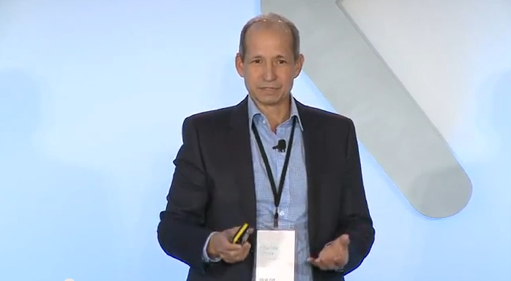A few weeks ago, I noted that there is a growing stable of companies, many small and some venture-backed, that is tackling the elusive challenge of nuclear fusion.
Driven by entrepreneurial spirit and not by the colossal state budgets that define the large international governmental fusion projects such as Europe’s ITER and the U.S.’s NIF, one or more of these entities is likely to crack the fusion nut first, I said.Almost on cue, another company has trotted into the fusion corral: U.S. aerospace stalwart Lockheed Martin.
Speaking last week at a Google “Solve for X” event (it’s a bit like a TED gathering, but organized by the ubiquitous search engine/media company), Charles Chase from Lockheed’s “Skunk Works” group described a transportable, 100-megawatt fusion machine that he said will be grid ready in 10 years and that – here’s a bold claim – could provide all the world’s baseload power by 2050.“There are still 1.3 billion people in the world without electricity,” Chase says in a YouTube video of his presentation.
Noting that the planet could nearly double its energy consumption by 2050 to 28 terawatt year, he says that the Lockheed fusion technology, “might be able to bring energy for everyone.”Like the smaller start-up companies that are gearing up to beat ITER and NIF to the grid, Lockheed’s fusion device shuns the massive size of the 20-story ITER tokamak under construction in France, and the 3-football-field-long NIF laser facility in Livermore, Calif., and does so by deploying technology that’s yet again different. A short list of other companies working on fusion variations include General Fusion, Helion Energy, Lawrenceville Plasma Physics (LPP) and Tri-Alpha Energy.
FIRST YOU TAKE SOME DEUTERIUM
The Lockheed machine heats deuterium gas with radio waves, generating a plasma that a magnetic field holds and confines. In principle, this confinement would hold long enough for deuterium to fuse with tritium – both are isotopes of hydrogen – creating helium and the all important heat that would then drive a turbine.It is a superior variation on the the ITER approach to magnetic confinement (NIF uses lasers, not magnets) that allows Lockheed to make a much smaller device, says Chase, whose LinkedIn profile identifies him as “senior program manager, revolutionary technology” at the Palmdale, Calif.
Skunk Works division of Bethesda, Md.-based company.Lockheed will build a sub-100MW prototype version by 2017 that will measure about 1-meter in diameter by 2-meters long. The 100MW grid-ready unit will be about twice that size, he says.Listening to Chase talk, I’m struck by how similar his claims are to those made by leaders and developers of fission alternatives to conventional nuclear, such as thorium and molten salt reactors.
He describes a reactor that is meltdown proof, leaves no long-lived radioactive waste, emits no CO2, and has a ridiculously higher energy density than fossil fuels. He also talks about the ease of transporting the compact machine on a truck, about desalination uses, about decentralized power in developing region, and, being from an aerospace company about how the machine could propel a craft to Mars in a speedy one month.
You’ll see that his list also includes “no proliferation issues” and “unlimited, low cost fuel supply.” I’m not sure any nuclear technology could ever absolutely claim either of these.On proliferation, let’s not forget that thermonuclear weapons rely on fusion technology. On a related note, California’s NIF facility is funded by a defense-oriented group at the U.S. Department of Energy, and one of NIF’s international partners is a U.K. Ministry of Defence group called the Atomic Weapons Establishment.
As for an unlimited supply of fuel, while deuterium is easy enough to obtain, tritium is a different story. Several fusion schemes call for extracting it in a fission reaction between lithium and neutrons emitted in the fusion process. And tritium’s radioactivity will require special attention.Then again, there are other fusion techniques, such as the “aneutronic” approach under development at LPP, Tri-Alpha Energy and elsewhere, that use different processes and elements.
THE IN-OUT CHALLENGE
And of course there’s no guarantee that Lockheed will manage to do what all fusion projects have failed at so far: harnessing more continuous energy than what goes into the reaction in the first place.To get there will require a top notch blend of science, engineering and money. On the money front, it is interesting to note that Chase presented in a Google forum. Google itself has made significant investments in sustainable energy including solar, wind and geothermal.
One would assume it is contemplating nuclear.Along the same lines, it was a venture capitalist, Steve Jurvetson, who broke the news about Chase’s Lockheed presentation last week – on the Flickr website. Juvertson is managing director of Silicon Valley VC firm Draper Fisher Jurvetson, whose investment portfolio includes technology standouts such as Tesla Motors, SpaceX and Hotmail.
As I noted in my CBS SmartPlanet blog earlier today, Jurvetson said nothing about backing the Lockheed project. But in the grand slam, home run oriented world of venture capital, you’ve got to believe that the possibility of solving fusion would keep guys like Jurvetson swinging. General Fusion and Tri-Alpha have already drawn VC funds.If the money bags are smart and broad in their thinking, they will also be looking at some of the fission alternatives. Fifteen percent of a thorium molten salt reactor company, anyone?





